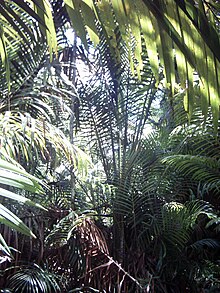
Roystonea is a genus of eleven species of monoecious palms, native to the Neotropics, in the Caribbean, the adjacent coasts of Florida in the United States, Mexico, Central America and northern South America. Commonly known as the royal palms, the genus was named after Roy Stone, a U.S. Army engineer. It contains some of the most recognizable and commonly cultivated palms of tropical and subtropical regions.

Phoenix reclinata, the Wild date palm, Afroasiatic date palm, Arabian date palm or Senegal date palm, is a species of flowering plant in the palm family native to tropical Africa, the Levant, the Arabian Peninsula, Iran, Madagascar and the Comoro Islands. It is also reportedly naturalized in the US, Mexico, Bermuda, Iberian Peninsula, Italy, Albania, Greece, Turkey, and the Leeward Islands. The plants are found from sea level to 3000 m, in rain forest clearings, monsoonal forests and rocky mountainsides.
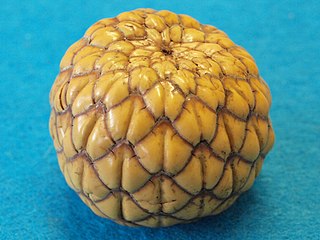
Metroxylon warburgii commonly called the natangura palm, is a species of flowering plant in the family Arecaceae. The specific epithet is in honor of Otto Warburg. The common name is from the Bislama name natanggura.
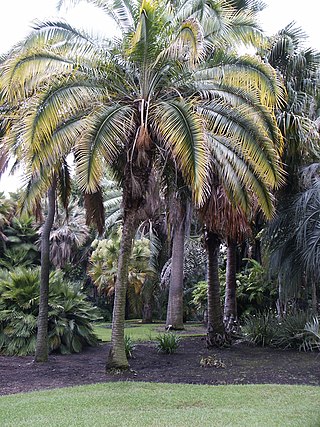
Phoenix rupicola or cliff date palm is a species of flowering plant in the palm family, native to the mountainous forests of India and Bhutan from 300 to 1200 m, usually occurring on cliffs, hillsides and similar terrain. It is threatened by habitat loss in its native range. On the other hand, the species is reportedly naturalised in the Andaman Islands, the Leeward Islands, Cuba and Puerto Rico and a specimen has recently been reported in Saint Lucia.

Phoenix sylvestris also known as silver date palm, Indian date, sugar date palm or wild date palm, is a species of flowering plant in the palm family native to southern Pakistan, most of India, Sri Lanka, Nepal, Bhutan, Myanmar and Bangladesh. It is also reportedly naturalized in Mauritius, the Chagos Archipelago, Puerto Rico and the Leeward Islands. Growing in plains and scrubland up to 1300 m above sea level, the fruit from this palm species is used to make wine and jelly. The sap is tapped and drunk fresh or fermented into toddy. The fresh sap is boiled to make palm jaggery in West Bengal state of India and Bangladesh.

Caryota urens is a species of flowering plant in the palm family, native to Sri Lanka, India, Myanmar and Malaysia, where they grow in fields and rainforest clearings, it is regarded as introduced in Cambodia. The epithet urens is Latin for "stinging" alluding to the chemicals in the fruit. Common names in English include solitary fishtail palm, kitul palm, toddy palm, wine palm, sago palm and jaggery palm. Its leaf is used as fishing rod after trimming the branches of the leaf and drying. According to Monier-Williams, it is called moha-karin in Sanskrit. It is one of the sugar palms.

Ammandra is a monotypic genus of flowering plants in the palm family found in Colombia and Ecuador, where it is endangered. The sole species is Ammandra decasperma, although another species name has been proposed. It is a pinnate-leaved, dioecious palm whose seeds and petioles are used in button and basket making, respectively. It is commonly called ivory palm or cabecita.
Barcella is a monotypic genus of flowering plant in the palm family found in the States of Amazonas and Roraima in northwestern Brazil. The only known species is Barcella odora which is used by the Brazilian peoples in construction and for various thatched goods.
Calamus calospathus is a rare species of flowering plant in the palm family found in peninsular Malaysia, where it is referred to as rotan demuk. It is not common in collections, nor has it been found in the wild for several years, leading some to conclude that the species may have become extinct. Under the synonym Calospatha scortechinii, it has been regarded as the sole species in the genus Calospatha. The epithet calospatha is a combination of two Greek words meaning 'beautiful' and 'spathe'.
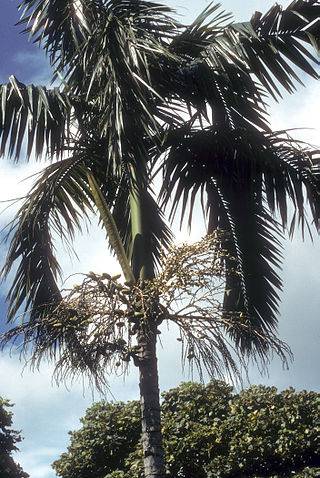
Actinorhytis is a monotypic genus of flowering plant in the palm family found in Oceania and southeast Asia. The lone species, Actinorhytis calapparia is a rain forest inhabitant and has very large fruit. The genus name is from two Greek words meaning 'ray' and 'fold' which describe the endosperm of the seed.
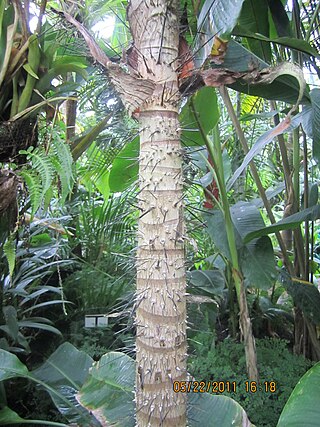
Dictyocaryum is a monoecious genus of flowering plant in the palm family found in South America. It is closely related to the genus Iriartea; they are commonly called araque or palma real. As many as eleven species have been described but this number is reduced to three in most current accounts. The genus name translates from two Greek words meaning "net" and "nut", describing the thick network of raphe fibers around the seed.

Dictyosperma is a monotypic genus of flowering plant in the palm family found in the Mascarene Islands in the Indian Ocean. The sole species, Dictyosperma album, is widely cultivated in the tropics but has been farmed to near extinction in its native habitat. It is commonly called princess palm or hurricane palm, the latter owing to its ability to withstand strong winds by easily shedding leaves. It is closely related to, and resembles, palms in the genus Archontophoenix. The genus is named from two Greek words meaning "net" and "seed" and the epithet is Latin for "white", the common color of the crownshaft at the top of the trunk.
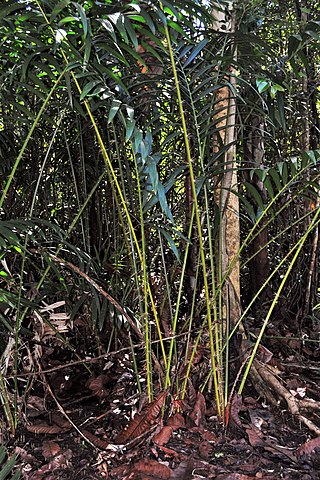
Eleiodoxa is a monotypic genus of flowering plant in the palm family found in Southeast Asia. The only species, Eleiodoxa conferta, is a dioecious, swamp-dwelling plant, commonly called by Malay as asam kelubi or asam paya. While five species names have been published, the other four are usually recognized as synonyms of the lectotype E. conferta. The genus is named from two Greek words meaning "water" and "glory" and the species name is Latin for "congested", an allusion to the flower spike.
Eremospatha is a genus of climbing flowering plants in the palm family found in tropical Africa. These rattans are uncommon in cultivation and poorly understood by taxonomists. Closely related to Laccosperma, they are differentiated by the near complete absence of bracts and bracteoles. The name is from Greek meaning "without a spathe".

Eugeissona is a clustering genus of flowering plant in the palm family native to Borneo, Thailand and Malaysia. The six monoecious species provide a wide range of local uses and are commonly called bertam or wild Bornean sago. The genus is the sole representative of the Eugeissoninae having very few obvious relatives; the hermaphrodite and staminate flowers are also found in Metroxylon, however the other specialized characteristics are unique suggesting an early split and differentiation from other members of the Calameae. Fossilized pollen belonging to these plants has been recovered in the lower and middle Miocene deposits in Sarawak. The name is from two Greek words meaning "good" and "roof", due to their common use in roof thatching.

Laccospadix is a monotypic plant genus in the palm family which is endemic to Queensland, Australia. The sole described species is Laccospadix australasicus, commonly called Atherton palm or Queensland kentia. The two Greek words from which it is named translate to "reservoir" and "spadix".
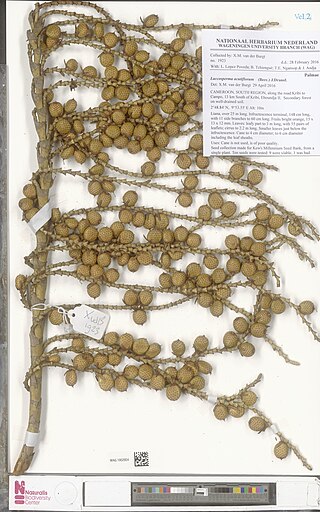
Laccosperma is a clustering genus of flowering plant in the family palm found in tropical Africa. Poorly studied and rarely cultivated, they are closely related to the genus Eremospatha and with it form a tribe in the Calameae characterized by dyads of hermaphrodite flowers. The genus name combines the Greek words for "reservoir" and "seed".

Lepidocaryum is a monotypic genus of flowering plant in the palm family from South America where the lone species, Lepidocaryum tenue, is commonly called poktamui. Nine species names have been published, but palm taxonomists currently agree that just one variable species includes them all. The most reduced member of the Lepidocaryeae, it is similar in appearance to three closely related genera, Mauritia, Mauritiella, and Lytocaryum. The genus name combines the Greek words for "scale" and "nut" and the species epithet is Latin for "thin".
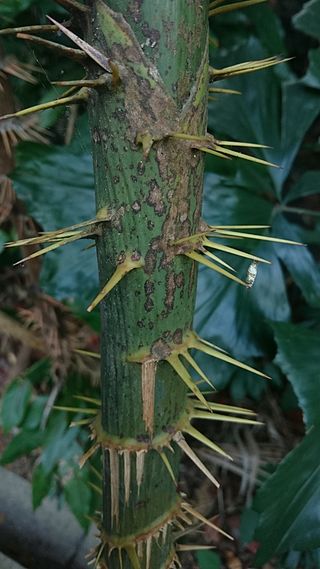
Myrialepis is a monotypic genus of flowering plant in the palm family. The single species, Myrialepis paradoxa, is native to Southeast Asia. The genus name is a combination of the Greek words meaning "innumerable" and "scale", a description of the fruit, and the epithet is Latin for "paradox".

Metroxylon vitiense is a species of flowering plant in the family Arecaceae, endemic to the islands of Fiji, Ovalau, and Vanua Levu in Fiji. There is only one confirmed occurrence of M. vitiense on Vanua Levu, just outside Savusavu. Despite it being considered a threatened species by the IUCN, as of February 2013 M. vitiense was still unprotected by Fijian regulations and international legislation. It has also been reported from the nearby islands of Wallis and Futuna.
